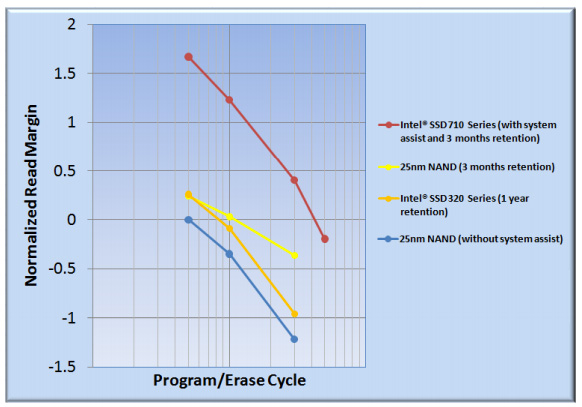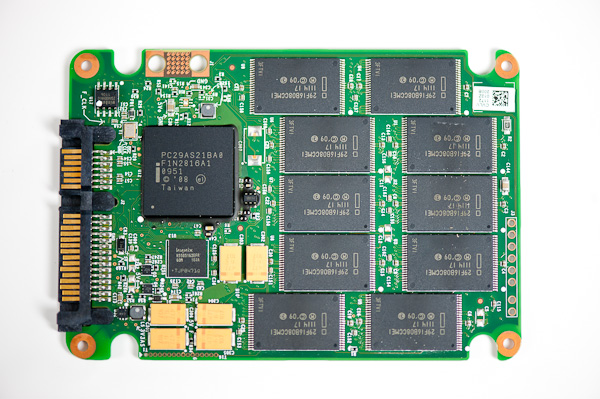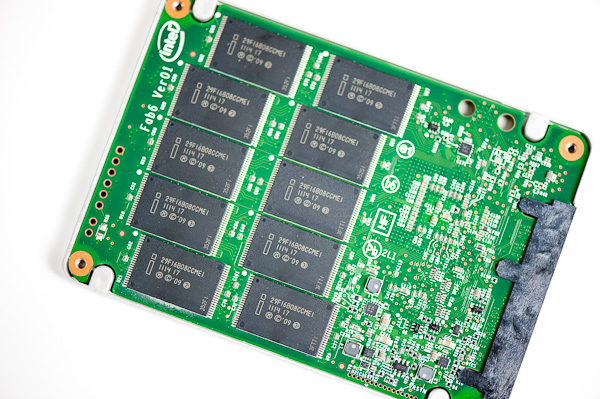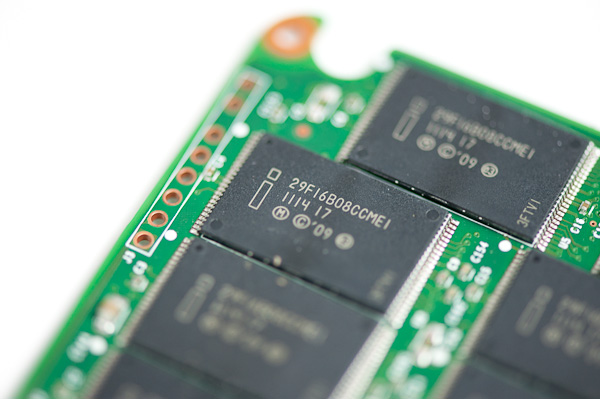The Intel SSD 710 (200GB) Review
by Anand Lal Shimpi on September 30, 2011 8:53 PM EST- Posted in
- Storage
- SSDs
- Intel
- Intel SSD 710
Total Bytes Written & Spare Area

90K p/e cycles seems a bit high and I can't find any Intel documentation that actually quotes that number, it's just what I heard at the 710 briefing in San Francisco. Luckily Intel has another metric it likes to use: total bytes written.
You don't get TBW for client drives, but for enterprise drives Intel will tell you exactly how many tera or petabytes of random 4KB or 8KB data you can write to the drive. These values are "up to" of course as actual lifespan will depend on the specific workloads.
| Intel SSD Endurance Comparison | |||||||
| X25-E 32GB | X25-E 64GB | 710 100GB | 710 200GB | 710 300GB | |||
| 4KB Random Writes | 1.0 PB | 2.0 PB | 500 TB | 1.0 PB | 1.1 PB | ||
| w/ +20% Spare Area | - | - | 900 TB | 1.5 PB | 1.5 PB | ||
Doing the math these values work out to be about 5K writes per cell (~5243), however that's assuming no write amplification. Performing a 100% random write across all LBAs for a full petabyte of data is going to generate some serious write amplification. The controller in the 710 tends to see write amplification of around 12x for 4KB random writes, which would put the rated cycle count at just under 63,000.
There's just one problem. The 200GB 710 I'm basing these calculations on doesn't actually have 200GB of NAND on-board, it has 320GB.
Opening up the 710 that Intel sent me I found a total of 20 NAND packages on-board. This isn't surprising as Intel's controllers have always supported 10 parallel NAND channels, in this case the 710 uses two packages per channel and interleaves requests to them. Each NAND package however has 128Gbit (16GBytes) of NAND inside in the form of 2 x 8GB 25nm MLC-HET die. Multiply all of that out and you get 320GB of NAND inside this 200GB drive.
Of course 200GB is defined as 200,000,000,000,000 bits, so actual binary storage capacity is 186.3GiB. This is absolutely insane: over 41% of the NAND on the 710's PCB is set aside as spare area. We have never reviewed an SSD with anywhere near this much spare area before.
If we run the p/e count with 320GB as the actual amount of NAND available, it works out to be just under 40K p/e cycles per cell. The significant spare area on the 710 increases the drive's projected lifespan by 55%! Intel even recommends setting aside another 20% of the drive if you need a longer lifespan. An extra 20% spare area will give you another 50% increase in total bytes written. Tinkering with spare area just helps reduce write amplification, it doesn't magically make the NAND cells last longer.
If we believe Intel's specifications, MLC-HET actually sounds pretty decent. You get endurance in the realm of the X25-E but at significantly lower cost and with more reasonable capacity options.
Thankfully we don't need to just take Intel's word, we can measure ourselves. For the past couple of years Intel has included a couple of counters in the SMART data of its SSDs. SMART attribute E2h gives you an accurate count of how much wear your current workload is putting on the drive's NAND. To measure all you need to do is reset the workload timer (E4h) and run your workload on the drive for at least 60 minutes. Afterwards, take the raw value in E2h, divide by 1024 and you get the percentage of wear your workload put on the drive's NAND. I used smartmontools to reset E4h before running a 60 minute loop of our SQL benchmarks on the drive, simulating about a day of our stats DB workload.
Once the workloads finished looping I measured 0.0145% wear on the drive for a day of our stats DB workload. That works out to be 5.3% of wear per year or around 18.9 years before the NAND is done for. I'd be able to find more storage in my pocket before the 710 died due to NAND wear running our stats DB.
For comparison I ran the same test on an Intel SSD 320 and ended up with a much shorter 4.6 year lifespan. Our stats DB does much more than just these two tasks however - chances are we'd see failure much sooner than 4.6 years on the 320. An even heavier workload would quickly favor the 710's MLC-HET NAND.
But what about performance? SLC write speeds are much higher than MLC, but Intel's MLC performance has come a long way since the old X25-E. Let's get to the benchmarks.
The Test
We're still building up our Enterprise Bench data so forgive the lack of comparison data here. We included a number of consumer drives simply as a reference point.
| CPU |
Intel Core i7 2600K running at 3.4GHz (Turbo & EIST Disabled) |
| Motherboard: |
Intel H67 Motherboard |
| Chipset: |
Intel H67 |
| Chipset Drivers: |
Intel 9.1.1.1015 + Intel RST 10.2 |
| Memory: | Qimonda DDR3-1333 4 x 1GB (7-7-7-20) |
| Video Card: | eVGA GeForce GTX 285 |
| Video Drivers: | NVIDIA ForceWare 190.38 64-bit |
| Desktop Resolution: | 1920 x 1200 |
| OS: | Windows 7 x64 |













68 Comments
View All Comments
Lifted - Friday, September 30, 2011 - link
If you're going to wear a t-shirt without a jacket, at least have something geeky/nerdy on it. ;)METALMORPHASIS - Friday, September 30, 2011 - link
After buying one of these drives all you can wear is just a plain t-shirt.EJ257 - Saturday, October 1, 2011 - link
Yeah like a t-shirt that say "I Void Warranties"http://www.thinkgeek.com/interests/techies/8f52/
michal1980 - Saturday, October 1, 2011 - link
PM your addy, and I'll send you a tee shirt that has a new collar. yours is stretched out.ph0masta - Saturday, October 1, 2011 - link
I'm not in the IT biz, yet as a computer tech enthusiast I still find it interesting. I'd to learn more about the high performance warez that are required to run enterprise class computing.dananski - Monday, October 3, 2011 - link
Stop going off topic, this is clearly about T-Shirts. :PLinkpl4y - Saturday, October 15, 2011 - link
I wonder if you could fry an egg on an SSD.http://www.foodrepublic.com/2011/10/14/how-fry-egg...
AdamK47 - Friday, September 30, 2011 - link
This is a good review, but are SSD reviews going to be the only interesting thing for the PC builder/overclocking community to view? You know, the foundation of which AnandTech was build on. I remember all of the great reviews for 7+ years ago. If it weren't for the forums, I really wouldn't be here still. Where are the Sandybridge-E previews or the Bulldozer previews? How about some good old fashioned overclocking analysis? Throw in some good gaming benchmarks while you're at it. I couldn't care less about business IT hardware, efficient HTPC, or Apple related reviews. Is this where your analysis team has deemed the direction the site should go in?dac7nco - Friday, September 30, 2011 - link
In all fairness, IT hardware is interesting to quite a few people. There are a few places here and there that benchmark games. I agree about the Apple reviews; I couldn't care less, and neither would most sane people.B3an - Saturday, October 1, 2011 - link
I also couldn't care less for anything Apple related. But sadly Apple articles seem to get quite a lot of attention so i doubt they'll be going away. It's like everything that does well... after a while things start to get more mainstream and you cant get more mainstream than Apples useless toys. I have no problem with this review at all though, i just hope these kinda detailed reviews dont disappear.